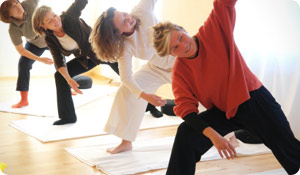
If you are living with fibromyalgia, then you well know the discomfort and pain that comes along with it. Many fibromyalgia patients fear that exercising will increase their pain, when actually the opposite is true. Research has shown that exercising twice a week for 25 minutes each time can result in immediate improvement of fibromyalgia symptoms.
Exercise can boost your energy, decrease pain and stiffness, and help you be more active in your life. The key to fibro-friendly exercises is to do low to moderate-intensity activities such as walking, swimming, water aerobics, biking, yoga, qui gong or tai chi. With all of these exercises it is important to start slowly, and gradually increase the intensity and duration as you can.
The following will provide you with some detailed information about fibro-friendly exercises that you can do either at home or in a class:
Exercising the joints. This is a great fibro-friendly exercise you can do at home. Start with your feet. Either sitting or standing, tense and then release your toes 5x to get circulation to the feet, then begin with gentle ankle rotations by making slow circular movements clockwise 5-10x, and then change directions to counterclockwise. Work your way up your body through all of your joints - knees, hips, spine, fingers, wrists, elbows, shoulders and neck. Move slowly and smoothly. Finish by sitting or standing quietly and taking 5 deep breaths.
Shake it out. This is a wonderful fibro-friendly exercise to get your day started (and can be done at home). Start by standing, taking a few deep breaths, and then shaking out your hands, fingers and wrists. Expand the shaking by adding your arms, shoulders, and (very gently) your head. Let out deep exhales as you shake out pain and stiffness. Next, move to your lower body. Shake out your hips, buttocks, legs, ankles and feet. Have fun with this. Shake out your whole body for one minute, letting out any sounds that need to release. After the minute is up, stand still, put your hands at your heart, close your eyes and just breathe for about 30 seconds.
Stretching. Stretching improves your circulation and sends nutrients and oxygen to your muscles and joints, increasing your range of motion so that moving around becomes easier. Try this simple, fibro-friendly stretching exercise: Sitting or standing, stretch your arms up toward the sky, hook your thumbs together and take 5 deep breaths. When you complete 5 breaths, turn slightly to the right and take 3 deep breaths, then turn slightly to the left and take 3 deep breaths. This is a wonderful stretching exercise to release tension and stiffness in your back, chest and shoulders.
Yoga. Yoga is a great way to increase your fitness when you have fibromyalgia. It is best to start yoga with a class, and is important to find a good instructor who understands fibromyalgia's challenges. Ask your doctor or fibromyalgia community for recommendations. Yoga postures can increase your muscle strength, improve your endurance and stamina, improve concentration, relieve depression, and help alleviate aches and pains through both deep and gentle stretching. Furthermore, yoga's focus on breathing can help improve circulation throughout your body, as well as relax your entire mind and body, allowing freedom from always focusing on pain.
Tai Chi. Tai chi has been called a "meditation in motion." It is wonderfully low-impact exercise that emphasizes relaxation. Studies have shown that tai chi can reduce fatigue, depression, anxiety, joint stiffness and pain in fibromyalgia patients. It can also improve mental clarity that is often compromised by fibro-fog. Tai chi is another fibro-friendly exercise that is best to start with a class. Ask your doctor or fibromyalgia community for recommendations.
Qigong. Studies on qigong and fibromyalgia show that qiqong helps improve energy, decreases fatigue, improves sleep, decreases fibro-fog, decreases anxiety and alleviates pain. This ancient Chinese exercise combines meditation, dance, movement, and breathing exercises. Ask your doctor or fibromyalgia community to recommend an instructor or a class.
Water aerobics. This is a wonderful fibro-friendly exercise since the buoyancy of water takes stress off the joints. Studies on the effect of water aerobics on fibromyalgia patients have shown that it reduces pain, improves strength, improves circulation and improves emotional health. Ask your doctor or fibromyalgia community to recommend a class.
Strength training. Studies performed by Harvard University have shown that a progressive regimen of strength training helps to reduce the symptoms of fibromyalgia. More specifically, strength training helps to reduce muscle pain and stiffness by encouraging daily use of all body parts; increases energy and reduces fatigue; improves sleep habits and alleviates symptoms of depression. Make sure to start out by working with a fitness instructor who understands the challenges of fibromyalgia.
Exercise is one of the most beneficial treatments for fibromyalgia symptoms. It can lessen your pain, strengthen your muscles, improve your mood, and make daily living a little bit easier. Talk to your doctor about getting started with any one of these fibro-friendly exercises.
Sources:
Evans, B., Romeling, M. et al. Strength Training for the Person with Fibromyalgia. National Fibromyalgia Association. June 21, 2007. http://www.fmaware.org/site/News2?page=NewsArticle&id=5279. Accessed Dec. 22, 2009.
McCall, T. Managing Fibromyalgia. Yoga Journal. http://www.yogajournal.com/health/1301. Accessed Dec. 22, 2009.
Nazario, B. (reviewed by). Fibromyaligia Exercise Slideshow: Stretching and Strengthening Exercises to Ease Fibromyalgia Pain. WebMD.com. Dec. 5, 2008. http://www.webmd.com/fibromyalgia/slideshow-fibromyalgia-friendly-exercises. Accessed Dec. 22, 2009.
Fibromyalgia Symptoms. Qigong. http://www.fibromyalgia-symptoms.org/fibromyalgia_qigong.html. Accessed Dec. 22, 2009.
Fibromyalgia Symptoms, Tai Chi. http://www.fibromyalgia-symptoms.org/fibromyalgia_tai_chi.html. Accessed Dec. 22, 2009.





